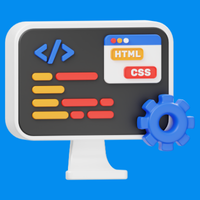React.js is one of the most powerful tools for building modern web applications. Businesses rely on a reliable React JS development company to create dynamic and interactive user interfaces. One critical decision for developers is choosing between CSS-in-JS and traditional CSS for styling. In this blog, we will explore these approaches in detail, discussing their advantages, disadvantages, and use cases.
Introduction to React.js Styling Approaches
Styling plays a crucial role in the development of React applications. Developers can use either CSS-in-JS or traditional CSS. A professional React JS development company understands the nuances of both techniques. CSS-in-JS allows developers to style components directly in JavaScript files. Traditional CSS involves writing styles in separate files and linking them to components. Each method has unique benefits and challenges. Choosing the right approach depends on project requirements, team expertise, and scalability needs.
Both methods offer flexibility for React JS development services, ensuring customizable solutions for web and mobile applications. While CSS-in-JS simplifies dynamic styling, traditional CSS excels in large-scale projects requiring modular and reusable styles. Balancing performance and maintainability is key when deciding which to use. Businesses leveraging React JS development must consider both techniques for their projects.
ReactJs Development Company
Top ReactJS App and web Development company Services

Advantages of CSS-in-JS
CSS-in-JS has gained popularity among developers. This approach integrates styles directly within JavaScript components. Collaborating with a skilled React JS developer ensures optimal implementation of CSS-in-JS. This technique eliminates class name collisions and enables scoped styles. It enhances code readability by keeping styles and components in one place. For projects requiring dynamic theming, CSS-in-JS is a game-changer.
Another advantage is improved maintainability for large teams. By coupling styles with components, developers minimize dependency issues. Teams providing React web development services benefit from this streamlined approach. However, CSS-in-JS can increase bundle size due to its runtime nature. Optimizing libraries like Emotion or Styled-Components can mitigate performance issues. Balancing innovation and efficiency is crucial in React development projects.
Look also this: Why Choose React for Your Next Web Application
Drawbacks of CSS-in-JS
Despite its benefits, CSS-in-JS has limitations. It can lead to performance overhead due to runtime style generation. Experienced teams in React development services mitigate these issues by pre-rendering styles. Another drawback is the steep learning curve for developers unfamiliar with JavaScript-based styling. Training a proficient React software team becomes essential for seamless adoption.
Moreover, CSS-in-JS lacks widespread browser support compared to traditional CSS. Developers must rely on polyfills or additional tools. Businesses seeking React mobile app solutions should consider these compatibility issues. Debugging can also be challenging, especially for complex animations. Balancing flexibility and simplicity remains critical for developers using CSS-in-JS. Proper tooling and expertise can address these challenges effectively.

Advantages of Traditional CSS
Traditional CSS is a time-tested method for styling web applications. It allows developers to write styles in external files and link them to components. A professional React app development team often uses traditional CSS for large-scale projects. This approach ensures consistency and modularity in styling. Stylesheets can be reused across multiple components, reducing redundancy.
Another advantage is browser compatibility. Traditional CSS works seamlessly across all modern browsers without requiring additional libraries. Teams specializing in React website development appreciate its simplicity and reliability. Additionally, tools like SASS and LESS enhance traditional CSS, offering features like variables and mixins. These features improve maintainability and scalability. Despite its advantages, managing large stylesheets can become challenging for complex projects.
Drawbacks of Traditional CSS
While traditional CSS is widely used, it has some limitations. Global namespace issues can lead to class name collisions, affecting style consistency. Partnering with a skilled React JS development company helps avoid these pitfalls. Another drawback is the lack of component-scoped styles, which can make debugging difficult. Developers must ensure proper naming conventions and structure.
Traditional CSS also requires additional tooling for dynamic styling. Teams providing React JS development services often use preprocessors or postprocessors. Managing multiple files can increase complexity, especially for small teams. However, for projects focused on simplicity and compatibility, traditional CSS remains a reliable choice. Balancing ease of use with scalability is key for successful React JS development projects.
Hire ReactJs Developer
ReactJs Development services offer end-to-end solutions for creating engaging, high-quality ReactJs Development platforms.

When to Use CSS-in-JS
CSS-in-JS is ideal for projects requiring dynamic styling and theming. It is particularly beneficial for single-page applications (SPAs). A skilled React JS developer leverages CSS-in-JS for projects needing scoped styles and modularity. This approach works well for teams familiar with JavaScript-based development. Libraries like Styled-Components and Emotion offer powerful features.
Teams providing React web development services use CSS-in-JS for highly interactive applications. This approach simplifies state-dependent styling and improves maintainability. However, it is essential to balance performance considerations. Pre-rendering styles and using optimized libraries can enhance efficiency. Businesses should collaborate with experienced developers to implement CSS-in-JS effectively for React development projects.
Look also this:React vs. Angular: Which is Better for Your Next Project?
When to Use Traditional CSS
Traditional CSS is best suited for projects requiring cross-browser compatibility and simplicity. Teams offering React development services rely on traditional CSS for large-scale applications. This approach ensures consistent styling across all components. Tools like SASS and LESS enhance traditional CSS, making it more flexible and scalable.
For businesses focused on reliability, traditional CSS is a trusted choice. It works seamlessly for React software projects requiring modular and reusable styles. Proper structuring and naming conventions can mitigate common challenges. By leveraging preprocessors and postprocessors, teams can enhance traditional CSS workflows. Choosing the right approach depends on the project’s complexity and team expertise in React mobile app development.

Balancing Both Approaches
In many cases, combining CSS-in-JS and traditional CSS can yield the best results. Teams providing React app development services use hybrid approaches for maximum flexibility. CSS-in-JS handles dynamic styling, while traditional CSS manages global styles. This combination leverages the strengths of both methods.
Collaboration is crucial for implementing hybrid approaches. Experienced React website development teams streamline workflows to balance performance and maintainability. Using tools like Webpack and Babel can integrate both techniques seamlessly. Businesses must work with skilled developers to adopt hybrid approaches effectively. The right strategy ensures optimal outcomes for React JS development company projects.
Conclusion
Styling React apps requires a careful evaluation of CSS-in-JS and traditional CSS. Each approach has its advantages and limitations. Partnering with a reliable React JS development company ensures the best outcomes. CSS-in-JS offers dynamic and scoped styling, while traditional CSS excels in simplicity and compatibility.
Businesses should consider their project’s requirements, scalability, and team expertise. Experienced developers provide tailored React JS development services for diverse needs. Balancing innovation with efficiency is key to successful React JS development. By choosing the right styling approach, businesses can create robust and visually appealing applications that stand out in the market.
Boost Profits with Expert ReactJs Development Company Services
Top ReactJS App and web Development company Services

SDLC CORP ReactJs Development Services Overview
SDLC Corp offers top-notch ReactJS development services, delivering fast, scalable, and interactive web applications tailored to your business needs. Our expert developers leverage ReactJS’s component-based architecture to build dynamic user interfaces, ensuring seamless performance, flexibility, and superior user experiences for businesses of all sizes. Partner with us for innovative React solutions.

















